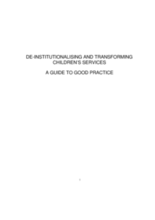This document begins with the paradigm that residential care is harmful to children and that community-based care is most beneficial to children. However, the movement from institutions to community-based care is challenging and complex.
Each chapter of this comprehensive guide outlines one of the 10 key steps to deinstitutionalisation:
- Raising awareness on deinstitutionalization: Provides research evidence on the negative effects of residential care
- Managing the process of deinstitutionalization: Provides a framework for developing a strategic plan for deinstitutionalization
- Analysis at regional/country level: Outline for conducting country/region analysis
- Analysis at institutional level: Outline for conducting institutional analysis
- Design of alternative services: Describes the necessary services for deinstitutionalization, including prevention, substitute care, community services
- Planning transfer of resources: An aid for projecting the costs of services
- Preparing and moving children: Highlights the trauma children experience when moved and how to support and monitor the children
- Preparing and moving staff: Addresses possible resistance of workers and assessing them for suitability in the new services
- Logistics: Planning for a timescale, preparation, movement, training and opening of new services
- Monitoring and evaluation: Outlines state and local responsibilities in deinstitutionalization
- Conclusions and recommendation: Broader perspective and summary of the model
The document also uses various case examples and visuals such as tables and figures to help illustrate the process.

